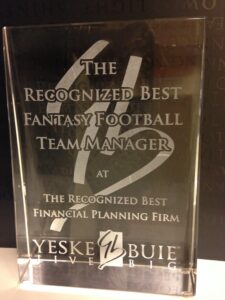Investing Lessons from Fantasy Football


It is estimated that over 50 million Americans played fantasy football last season, with projections for this year’s season to be even more popular. If you didn’t play in a fantasy football league (or multiple) this year, then you almost certainly know someone who played. This year’s winner of the coveted title of Recognized Best Fantasy Football Manager is Yusuf Abugideiri CFP, Chief Investment Officer and Partner.
In addition to being a source of fun and team bonding for our team (the league has a history of being competitive, especially with the addition of a trophy for the winner and a different kind of “prize” for the loser introduced in 2015 – more on that later), there are a number of investing lessons that you can take away from engaging with this game. In this space, we’ll share a brief overview of the game for those who are less familiar, give you an inside look into some of our nerdy shenanigans, and draw three connections between investing and fantasy football. We hope you enjoy!
An Inside Look at Yeske Buie’s Nerdy Financial Planning Team
Client Support Specialist, Will Tracy, has been serving as the league’s commissioner and unofficial sportscaster over the last two seasons. This role includes sending a weekly email to the team recapping the previous week’s matchups and the best and worst decisions by managers each week.
In addition to some internal shenanigans, these emails have surfaced several references to financial planning and investing behaviors…
- After Week 1, Gavin Shoults asked Will how many points a touchdown was worth and what a Quarterback does. Will helped Gavin review some of his players and decisions from the opening week, and they joked together that Gavin was an “uneducated investor” when it came to making lineup decisions.
- In Week 7, Kacie Fawls dropped Puka Nacua from her roster due to his lack of recent production stemming from an early-season injury. Tim Connolly noticed this roster change and added Puka to his team. The following week, Puka played his first game in nearly two months and tallied an impressive 106 receiving yards. He went on to have a great rest of the season. Reflecting on this transaction, Will jokingly said that Kacie was “Buying high and selling low”.
What do these quotes say about us? Hopefully that we’re really passionate about what we do!
Connections Between Fantasy Football and Investing
Even when having fun, it’s natural for us to draw connections between the entertainment we’re consuming and the work we do for our Clients. Consider these connections between serving as a fantasy football team manager and Yeske Buie’s investment philosophy:
- Don’t Overvalue Glamour: Just as a diversified portfolio may include some glamour stocks (i.e. stocks trading at valuations higher than the average) as a part of a broad market index, a functional fantasy football team must have a quarterback. Quarterback is the most highly paid position in the NFL, but that doesn’t directly correspond to their priority regarding fantasy draft status; just because something is expensive doesn’t mean it’s commensurately valuable.
- Don’t Undervalue Low-Cost Investments: Research shows that, over the long run, value stocks (i.e. stocks trading at valuations lower than average) tend to outperform glamour stocks, and Yeske Buie’s portfolios are designed to capitalize on that. Similarly, a good fantasy football manager looks to add undervalued players (rookies or players new to their roles) to his/her roster with the aim of “buying low and selling high”.
- External Factors Matter: Just as the markets can be influenced by geo-political considerations, non-football factors must be taken into account when configuring one’s starting lineup. A good manager must consider the weather in which the player will be competing, as well as nuances like distance traveled (ex. players from West Coast teams are notorious for performing poorly in early afternoon games on the East Coast, as their body clocks are still adjusting to the time difference). Of course, in the end, no matter how much one may try to manage these external factors, the results are driven more by random chance than anything else.


